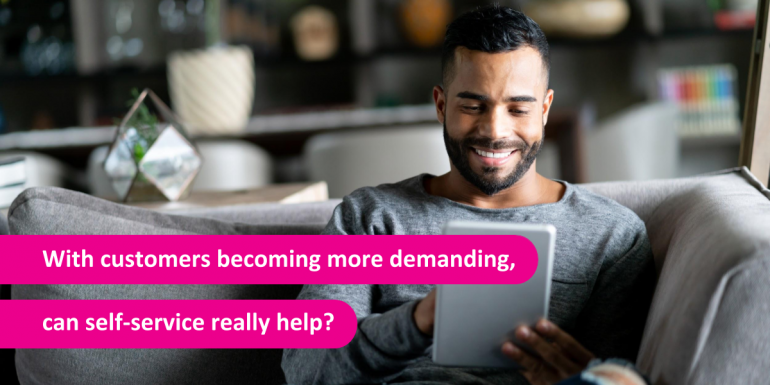With customers becoming more demanding, can self-service really help?

Customer service is continually increasing in complexity. Consumers are not only becoming more demanding, but they also want faster responses, with minimal effort on their part. They also expect a seamless experience as a bare minimum, no matter which channel(s) they use to contact your brand.
Recent analysis carried out by Gartner backs this up and explains more about what is driving increased pressures on customer service teams:
1. More channels = more contacts
Contrary to what you might think, introducing new channels doesn’t just deflect contacts from existing ones. In fact, Gartner’s research highlights that the more channels you have, the more contacts you will receive overall. For example, companies with 7+ channels averaged 3.1 contacts per customer journey, while those with 3 channels received just 2 contacts on average.
Eptica’s own research supports this idea that the number of contacts is on the rise. We found that the average UK consumer contacts brands nine times per month with a reasonably even split between channels. In fact, 88% of consumers we questioned in our survey said they now contact companies more or the same number of times as five years ago – with 16% stating they now get in touch with brands more than twice as often.
2. This all drives up costs
As you might expect, as well as contacting brands more often and using a wider number of channels, customers want the convenience of being able to switch easily between those channels during their journey. This includes being able to move seamlessly between self-service systems and live agents, as Gartner’s report shows:
- 30% of customer journeys solely involved contacts with live agents
- 9% used self-service only
- 61%, therefore, used a mix of both
Obviously, the greater number of channels used, and the degree of live agent involvement, all push up costs. Gartner estimates that live channels cost $8.01 per contact, compared to $0.10 for self-service. So, for a journey that starts on self-service and then involves three contacts on live channels, the cost quickly rises to $24.13.
Gartner outlines four ways to manage these pressures, and ensure that while you still providing choice, you are maximizing the use and impact of self-service:
1. Establish a self-service strategy that prioritizes resolution, not channel choice
Ensure leadership and management time is devoted to overseeing the role played by self-service and align resources with those channels that actually resolve customers’ queries, rather than simply providing a wider channel choice. For example, research by Eptica into the effectiveness of different channels within the travel sector found that just three brands (out of ten) were able to correctly answer 100% of customers’ questions via their websites – with two rivals only answering 40% of questions. This failure to resolve queries online will clearly push consumers to more expensive live channels unnecessarily – that’s if they don’t take their business elsewhere.
2. Manage self-service capabilities like a product, not an IT project
Introducing self-service is not a one-off project that can be forgotten once it is up and running. It is vital to manage and monitor self-service capabilities as you would a product with measurable, ongoing ROI goals. The goals you monitor should be tied to reducing the volume of queries as well as boosting the customer experience, such as resolution rate, CSAT or effort by the customer. At the same time, you need to make sure self-service channels stay up to date and relevant by ensuring they are underpinned by a constantly updated, comprehensive, knowledge base.
3. Prevent self-service abandonment through confidence-building design
When customers choose to use self-service, you need to ensure they’re given clear and actionable information about what they need to do; confirm to them that you are taking steps to resolve their issue and make it clear that the information or advice they are receiving is credible. This increases the customer’s confidence in the system, reduces the chance of frustrations or other negative emotions and stops them from switching unnecessarily to a live agent.
It is also important to understand the emotions that underpin the questions that come in through self-service. AI and natural language processing systems can analyze the text in incoming customer communications and identify the emotional context; for example, if the communications indicate a customer is frustrated or upset, they can be fast-tracked or routed to a live agent.
4. Evolve talent management practice for a self-service dominant strategy
If routine queries are being answered via self-service successfully, it stands to reason that the remaining questions coming to live agents will be more complex. Therefore, you need to look after and nurture live agents as a valuable resource, focusing your efforts on the retention of top talent and training them to take control of these more involved customer interactions. Reskill and upskill agents to ensure they can handle more complex queries and have the expertise to work across a number of channels.
Overall, it’s essential to put in place a holistic strategy that maximizes self-service but doesn’t forget the 30% of journeys that only use live agents. Ensure you have a joined-up approach that supports all customer channels – and all of them powered by the same centralized knowledge base to ensure consistency and accuracy. At the same time, you should make it easy for customers to switch back and forth between channels if they need to - and enable self-service technology and live agents to work together side by side. Only then will you be able to handle the rising volume of more complex queries successfully while keeping customers happy.






